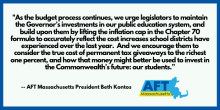As legislators prepare to examine the education portion of Governor Healey’s FY24 state budget proposal today, AFT Massachusetts President Beth Kontos praised the Governor’s proposals for increases to education spending, but issued a warning about the impact of proposed tax cuts on future budgets.
“The Governor’s education spending proposal is a big step forward for students and educators in Massachusetts, and represents the Governor’s prioritization of students and their families in her first months in office,” said Kontos. “The Governor’s budget would fully implement another year of the Student Opportunity Act, resulting in more funding for our highest-need schools to hire teachers and support staff, close achievement gaps, and offer the wraparound services our students need to recover from the stresses of the pandemic. At our public colleges and universities, the Governor’s proposal would deliver significant progress on affordability for students while also protecting funding for campuses so they can deliver high-quality education and support services.”
“However, we are concerned that spending hundreds of millions of dollars on tax cuts for the ultra-rich could threaten the Commonwealth’s ability to make good on its education promises in future years,” she continued. “This budget represents only the third of six years of major increases to K-12 education spending that are required under the Student Opportunity Act. Amid record inflation that is straining school budgets, careful financing planning will be required to ensure that this promise to our highest-need students is fulfilled over the next three years. And while the Governor’s budget makes notable investments in public higher education that will begin to make up for the devastating cuts our campuses have experienced over the past few decades, even greater funding will be required to achieve our goal of a fully-funded, fully debt-free public college system.”

“As the budget process continues, we urge legislators to maintain the Governor’s investments in our public education system, and build upon them by lifting the inflation cap in the Chapter 70 formula to accurately reflect the cost increases school districts have experienced over the last year,” she concluded. “And we encourage them to consider the true cost of permanent tax giveaways to the richest one percent, and how that money might better be used to invest in the Commonwealth’s future: our students.”
The Governor’s FY24 budget proposal contains numerous increases to K-12 education-related line items:
- $6.585 billion in Chapter 70 school aid, a $586 million (9.8%) increase over FY23, which would represent full funding of the Student Opportunity Act for the third year of a planned six-year implementation period.
- $243 million to fully fund the charter school reimbursement line item.
- $503 million for the Special Education Circuit Breaker, a $63 million (14%) increase over FY23, which would reflect a full phase-in of out-of-district transportation cost reimbursement provided for in the SOA.
- $130.9 million for school transportation reimbursement programs, a $25.5 million (24%) increase over FY23, to better account for districts’ increased costs to transport students.
However, the proposed budget does not waive the inflation cap in the Chapter 70 school funding formula, as has been done in past periods of record inflation. This means that state funding will not reflect the actual increased costs school districts are facing for heat, electricity, equipment, and other costs, threatening the state’s ability to meet the ultimate spending targets of the Student Opportunity Act in real dollars.
The budget also proposes $39.7 in state aid to local and regional libraries, a 4.5 million increase over FY23, and proposes several major increases to public higher education funding:
- A $93 million expansion of the MASSGrant Plus scholarship program for low-income undergraduate students to cover part-time students and cover additional direct costs of attendance such as books and supplies.
- $59 million to lock tuitions at UMass and state universities so that incoming students do not experience tuition increases once they are enrolled, and to freeze community college tuition and fees for one year.
- A 3% increase to campus operational funding: $10.1 million for community colleges, $9.8 million for state universities, and $19.3 million for UMass.
- $140 million for additional one-time investment in capital improvements to campuses.
- $38.8 in new funding for student support services including high-quality academic and wraparound services, mental health initiatives, and the Supporting Urgent Community College Equity through Student Services (SUCCESS) Fund.
- $20 million for the MassReconnect scholarship program to provide students 25 years of age and older the opportunity to obtain a free degree at any public community college in the Commonwealth.
Accompanying the Governor’s budget is a proposal for permanent changes to the Commonwealth’s tax system, including several policies targeted to low- and middle-class families:
- A $600 annual Child & Family Credit for qualifying dependents, including children, disabled adults, and seniors, fully refundable, and available at all income levels. Total cost: $458 million/year.
- A doubling of the maximum allowed Senior Circuit Breaker Credit for low-income seniors from $1,200 to $2,400. Total cost: $60 million.
- An increase in the cap on the rental deduction from $3,000 to $4,000, giving some renters an additional $50. Total cost: $40 million.
The tax proposal also includes two policies targeted largely to the ultra-rich:
- The elimination of the estate tax on estates under $3 million, and a $182,00 reduction in estate taxes for all larger estates. Total cost: $275 million/year.
- A cut to the short-term capital gains tax rate, paid on income made from investments that are bought and then sold in less than a year, from 12% to 5%. Total cost: $117 million/year.
